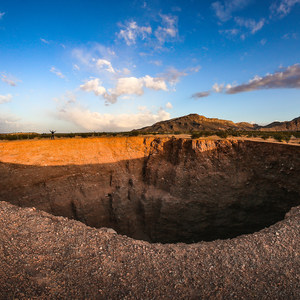The Petroglyph Trail, also referred to as the Falling Man Petroglyph Trail, is a short hike within Gold Butte National Monument that leads to an area especially rich in petroglyph rock art.
Within a short walk, this trail passes numerous petroglyph sites, agave roasting pits, an abundance of flora and tinajas, and scars from past campers and visitors using some of the petroglyphs for target practice. Signs and simple wooden posts at the trailhead warn of restricted use; however, this trail makes a good case for the protection of historical sites. Gold Butte was managed by the Bureau of Land Management until 2016, when it was designated as a national monument.
The hike begins on an easy-to-follow trail that soon gets harder and harder to trace as it heads into the stone formations. Though elevation gain along the trail is negligible, a fair amount of scrambling up large rock formations is necessary in order to see many of the petroglyphs and maneuver to other areas.
Upon beginning the trail, the first gallery can be seen about 0.1 mile into the trail. Look to the right for a large rock "rabbit ear" formation. If you scramble up to the bottom of the "ears," a petroglyph gallery exists there.
Further down the trail, a large boulder toward the right is known as Calvin's Rock, named after Calvin Meyers, former Chairman of the Moapa Band of Paiutes and environmental activist. Around this area the trail fades, and many smaller paths disperse to galleries and clusters of petroglyphs. In all there are well over 100 of them in the area.
The history of the petroglyphs is unknown. Western Anasazi inhabited this area several thousand years ago, and more recently Southern Paiute Indians traveled through here. The petroglyphs may date anywhere from 700 to several thousand years old.
Barrel cactus, creosote, and Joshua trees abound. Following the wet season, there may be an abundance of wildflowers in bloom. Desert tortoise and bighorn sheep also make their home in these hills.
As of summer 2017, there is no official map or trail description of this hike or area. A good internet search may result in detailed directions to some of the petroglyph galleries. With no trail, there is no set hiking distance, but walking 1.5 to 3 miles total will give you a good amount of coverage of the area. Plan ahead as there is no cell service anywhere in Gold Butte National Monument.
A four-wheel drive vehicle with clearance is suggested. However, under most conditions a standard car should be able to make the drive to the trail if you take it very carefully. Road signage is nearly nonexistent in the monument, so plan your navigation ahead.
There are no amenities of any kind at the trail.
























Comments
Sign In and share them.